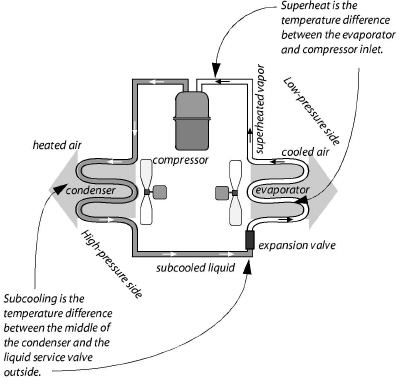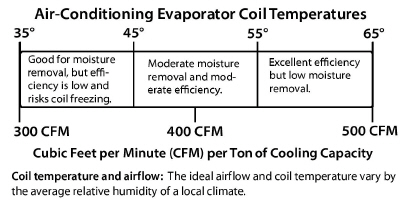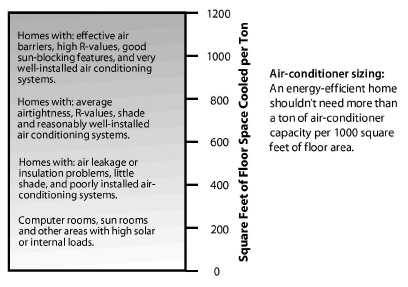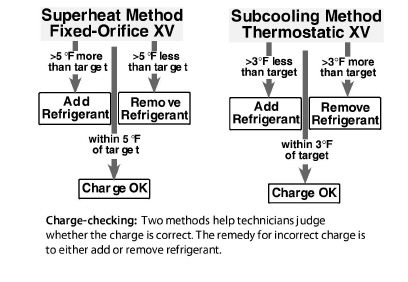
8.21 Evaluating Ducted Central Air-Conditioning Systems
|
SWS Detail: 5.3003.4 Evaluating Electrical Service, 5.3003.26 Electrical Service—Mid and High Rise |
An energy-efficient home shouldn’t need more than a ton of air-conditioning capacity for every 1000 square feet of floor space. Window shading, attic insulation, and air leakage should be evaluated together with air-conditioner performance to size an air conditioner.
The following four installation-related problems are characteristic of central air conditioning systems.
1. Inadequate airflow
2. Duct air leakage
3. Incorrect charge
4. Oversizing
Refrigerant-charge testing and adjustment come after duct testing and sealing, which comes after airflow measurement and improvement.
The recommended airflow rate for central air-conditioning systems is between 350 CFM and 450 CFM per ton of refrigeration capacity. Heat pump airflow rate should be between 400 CFM and 450 CFM per ton.
|
Installation-Related Problem |
%B |
Savings Potential |
|---|---|---|
|
Duct air leakage (avg. 270 CFM25)C |
70% |
17% avg. |
|
Inadequate airflow |
70% |
7% avg. |
|
Incorrect charge |
74% |
12% avg. |
|
Oversized by 50% or more |
47% |
2–10% |
|
AReport sponsored by Environmental Protection Agency (EPA) and compiled from research from Multiple Field Studies BPercent of tested homes found with a significant problem. CThe number of homes of the duct-leakage studies was around 14,000; the number for the other problems was over 400 each. |
8.21.1 Central A/C-Heat Pump Inspection and Maintenance
|
SWS Detail: 5.3003.7 Occupant Education, 2.0702.2 Occupant Education, 2.0702.3 Building Operations Staff Education |
Air conditioners move a lot of air, and that air contains dust. The filter in the air handler catches most large dust particles. However some dust travels around or through the filter, depending on the filter and its mounting assembly. The condenser coil outdoors isn’t protected by a filter and is usually quite dirty.
Dirt enters the coil from the outside. The goal of this procedure is to drive the dirt out by spraying inside to outside. With high-pressure water, however, you can drive the dirt through the coil and into the cabinet where it drains out through drain holes.
✓ Inspect the condenser coil and know that it is probably dirty even if it looks clean on the outside. Take a flat toothpick and scrape between the fins. Can you scrape dirt out from between the fins?
✓ Use a stiff-bristle brush to remove visible surface from the outside of the condenser coil.
✓ Apply a biodegradable coil cleaner to the outside of the coil. Then spray cold water through the coil, preferably from inside the cabinet. Many coils can tolerate a high-pressure spray but others need low-pressure spray to avoid bending the fins.
✓ Straighten bent fins with a fin comb.

Cleaning the Evaporator Coil
Dirt enters the filter, blower, and coil from the return plenum.
✓ Inspect the filter slot in the air handler or the filter grille in the return air registers. Do the filters completely fill their opening? Are the filters dirty?
✓ Inspect the blower in the air handler after disconnecting power to the unit. Can you remove significant dirt from one of the blower blades with your finger? If the blower is dirty, then the evaporator coil is also dirty.
✓ Clean the blower and evaporator. Rake surface dirt and dust off the coil with a brush. Then use an indoor coil cleaner and water to clean between the fins.
✓ Straighten bent fins with a fin comb.

Calculate the correct size of an air conditioner before purchasing or installing it. The number of square feet of floor space that can be cooled by one ton of refrigeration capacity is determined by the home’s energy efficiency. Air-conditioners provide cooling most cost-effectively when they are sized accurately and run for long cycles.

The cooling-cost reduction strategy should focus on making the home more energy efficient and making the air conditioner work more efficiently. Making the home more efficient involves shading, insulation, and air-leakage reduction. Making the air conditioner more efficient involves duct sealing, duct insulation, and a quality installation.
8.21.3 Duct Leakage and System Airflow
Unfortunately, duct leakage and poor airflow afflict most air-conditioning systems. The testing and mitigation of these problems was covered earlier in this chapter.
1. See “Air Filter Effectiveness” on page 339.
2. See “Ducted Air Distribution” on page 321.
8.21.4 Evaluating Air-Conditioner Charge
|
SWS Detail:5.3003.23 Refrigerant Charge Evaluation—Low Rise, 5.3003.13 Refrigerant Charge Evaluation, 2.0302.1 Locking Refrigerant Caps—Mid and High Rise, 5.3003.5 Refrigerant Line Inspection |
Air-conditioning replacement or service includes refrigerant charge-checking. HVAC technicians evaluate refrigerant charge by two methods depending on what type of expansion valve the air conditioner has.
1. If the expansion valve has a fixed orifice, the technician performs a superheat test.
2. If the valve is a thermostatic expansion valve (TXV), the technician performs a subcooling test.

These two tests indicate whether the amount of refrigerant in the system is correct, or whether there is too much or too little refrigerant. The amount of refrigerant is directly related to the efficiency of the air-conditioning system.
Perform charge-checking after the airflow tests, airflow adjustments, and duct-sealing are complete. Do charge-checking during the cooling season while the air conditioner is operating.
Note: In multifamily buildings, install locking refrigerant caps on refrigerant access ports, if required by code, and as required by the SWS.